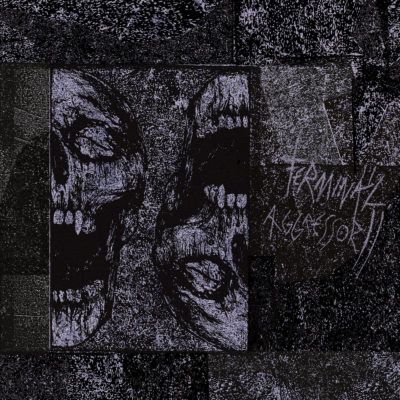
By Nicolas Ruiz
Silently creeping out of the mysterious dungeons where they lurk, the death/doom metal band Dragged into Sunlight is back after half a decade with a new release. Known for their dark, twisted experience that was their 2009 debut Hatred for Mankind, Dragged into Sunlight is a name that has been echoed in the underground hall of fame, yet had not released any recent music for half a decade. I think part of the appeal of this band is their “on our own terms” persona, an image heightened by recent accusations they’ve levied against their former label. Without even an interest in revealing the identities of the members or the location of origin, the band writes and releases whatever odd album it wants, be it a first-class doom metal album, an odd 2015 collaboration with fellow band Gnaw Their Tongues, or in this case… a single 28 minute track.
Terminal Aggressor II is technically a single, but due to its enormous length I like to refer to it as an EP. Many readers or listeners would naturally question why a single track would extend to this length, so I’ll answer that first. As it turns out, the answer lies in the pacing. The track very slowly builds up to a climax over such a long period that the true “song” begins halfway through. The first half of the track could probably qualify as some ambient noise track. Even the first three minutes are little more than static! But despite how unappealing that may sound, it’s actually quite sensible because it plays to Dragged into Sunlight’s strengths. This band has proven in the past that they can create a morbose, uncomfortable atmosphere with their music, but they need time to build it up and set the scene.
And it works very well, because by the time the metal kicks in, the mood is set up and the listener already has an image of the setting in their head, and the music can take advantage of that. I previously mentioned that they were a death/doom metal band, but the genre of this music isn’t as clear-cut as I’m making it out to be. I’ve already hinted that the first half of this track is more dark ambient than metal, but what about the second half? You can expect a lot of extreme influences here. It has the extremity and heaviness of death metal, despite not nearly matching the conventional speed of the genre. It instead shares the same speed as slower, doom-like or sludge-like bands such as Eyehategod. I’m not saying they’re comparable to Dragged into Sunlight on an atmospheric level, but the pace these bands perform at is quite similar.
There are smaller examples of various other influences, like the occasional guttural vocals that sound like they were taken from Whitechapel, or the depressive, nihilistic sound that grim bands such as Xasthur or Leviathan would abuse. And boy, is it nihilistic! Definitely a difficult listen for the average person, and even for a seasoned metalhead, this may be one of the more extreme releases that will come out this year. And it keeps building on to itself as it progresses. More and more does the rhythm of the song change, and with it follow the background noises and the little bells and whistles: fuzzy static, quote sampling, extended guitar notes that turn into piercing sounds… this is all thanks to the mixing, which gives each instrument and sound some time and space to be heard, but not compromising the brutality of the track itself.
Overall, it’s a great experience, and it pays off well if one has the patience to listen through the whole thing. I daresay it’s even the best metal release from January. I think that if any metalhead reading this can take darker music, or if there are any dark ambient fans that don’t mind metal, this should be one to check out. Hopefully it doesn’t take another half-decade to hear from this band again.
Listen:
Bandcamp: https://draggedintosunlight-official.bandcamp.com/album/terminal-aggressor-ii
iTunes: https://music.apple.com/us/album/terminal-aggressor-ii-ep/1484903602
Spotify: https://open.spotify.com/album/1ueNSUwC5XgppRKb2loO4O?si=RBIJsoL9SDG6IO4fqCEhtA

